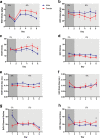Temporal analysis of individual ethanol consumption in socially housed mice and the effects of oxytocin
- PMID: 33404737
- PMCID: PMC7786142
- DOI: 10.1007/s00213-020-05741-3
Temporal analysis of individual ethanol consumption in socially housed mice and the effects of oxytocin
Abstract
Rationale: The majority of preclinical studies assessing treatments for alcohol use disorder use singly housed animals. Because social factors affect ethanol intake, studies investigating such treatments in group-housed animals are needed.
Objectives: We investigated the effects of repeated oxytocin treatment on ethanol intake in socially housed male and female C57BL/6J mice.
Methods: We used the novel "Herdsman" system implementing radiotracking technology to measure individual ethanol intake in group-housed animals. Mice were housed in same-sex groups of 4 per cage and exposed to 3 and 6% ethanol solutions. After baseline drinking was established, half of the animals in each cage received repeated intraperitoneal injections of 3 mg/kg oxytocin.
Results: During baseline, females consumed more ethanol than males partly due to greater number of ethanol drinks taken by females. We also observed a gradual development of two peaks of ethanol consumption during the dark phase of the circadian cycle. The effects of oxytocin treatment were short-acting and varied across treatment days. Oxytocin significantly decreased ethanol intake on three out the four treatment days. On the fourth treatment day, oxytocin decreased ethanol intake and water intake.
Conclusion: The greater intake of ethanol in female mice is associated with the number of drinks taken. Oxytocin treatments not only cause an acute decrease in ethanol consumption, but can also change in efficacy over time. While the oxytocin system remains a promising therapeutic target for alcoholism, studies investigating longer periods of repeated oxytocin treatment and those using additional oxytocin receptor agonists are warranted.
Keywords: Alcohol; Drink size; Ethanol preference; HM2; Oxytocin; RFID; Radiofrequency identification; Sex differences; Socially housed; Two-bottle choice.
Conflict of interest statement
The authors declare that they have no conflict of interest.
Figures






Similar articles
-
Differential effects of baclofen and oxytocin on the increased ethanol consumption following chronic psychosocial stress in mice.Addict Biol. 2013 Jan;18(1):66-77. doi: 10.1111/adb.12001. Epub 2012 Nov 6. Addict Biol. 2013. PMID: 23126471
-
Assessing effects of oxytocin on alcohol consumption in socially housed prairie voles using radio frequency tracking.Addict Biol. 2021 Mar;26(2):e12893. doi: 10.1111/adb.12893. Epub 2020 Mar 11. Addict Biol. 2021. PMID: 32160654 Free PMC article.
-
Social Housing Leads to Increased Ethanol Intake in Male Mice Housed in Environmentally Enriched Cages.Front Behav Neurosci. 2021 Jun 18;15:695409. doi: 10.3389/fnbeh.2021.695409. eCollection 2021. Front Behav Neurosci. 2021. PMID: 34220465 Free PMC article.
-
Oxytocin as a treatment for alcohol use disorder and heavy drinking: A narrative review.Exp Clin Psychopharmacol. 2024 Dec;32(6):625-638. doi: 10.1037/pha0000741. Epub 2024 Sep 19. Exp Clin Psychopharmacol. 2024. PMID: 39298263 Review.
-
Barriers and Breakthroughs in Targeting the Oxytocin System to Treat Alcohol Use Disorder.Front Psychiatry. 2022 Feb 28;13:842609. doi: 10.3389/fpsyt.2022.842609. eCollection 2022. Front Psychiatry. 2022. PMID: 35295777 Free PMC article. Review.
Cited by
-
A Novel Mouse Home Cage Lickometer System Reveals Sex- and Housing-Based Influences on Alcohol Drinking.eNeuro. 2024 Oct 9;11(10):ENEURO.0234-24.2024. doi: 10.1523/ENEURO.0234-24.2024. Print 2024 Oct. eNeuro. 2024. PMID: 39317464 Free PMC article.
-
The Role of Oxytocin and Vasopressin in Drug-Induced Reward-Implications for Social and Non-Social Factors.Biomolecules. 2023 Feb 21;13(3):405. doi: 10.3390/biom13030405. Biomolecules. 2023. PMID: 36979340 Free PMC article. Review.
-
Effects of social housing on alcohol intake in mice depend on the non-social environment.Front Behav Neurosci. 2024 May 16;18:1380031. doi: 10.3389/fnbeh.2024.1380031. eCollection 2024. Front Behav Neurosci. 2024. PMID: 38817806 Free PMC article.
-
A novel mouse home cage lickometer system reveals sex- and housing-based influences on alcohol drinking.bioRxiv [Preprint]. 2024 May 23:2024.05.22.595186. doi: 10.1101/2024.05.22.595186. bioRxiv. 2024. Update in: eNeuro. 2024 Oct 9;11(10):ENEURO.0234-24.2024. doi: 10.1523/ENEURO.0234-24.2024. PMID: 38826244 Free PMC article. Updated. Preprint.
-
Characterization of social hierarchy formation and maintenance in same-sex, group-housed male and female C57BL/6 J mice.Horm Behav. 2024 Jan;157:105452. doi: 10.1016/j.yhbeh.2023.105452. Epub 2023 Nov 16. Horm Behav. 2024. PMID: 37977023 Free PMC article.
References
MeSH terms
Substances
Grants and funding
LinkOut - more resources
Full Text Sources
Other Literature Sources
Medical

